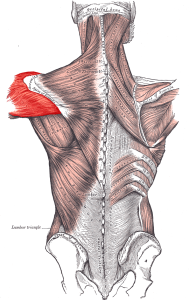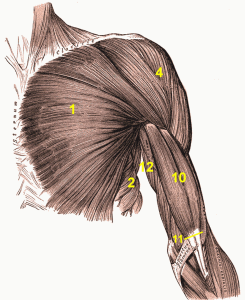Learn Anatomy through Animation Software

Henry Gray (1827-1861) meticulously illustrated, in “Gray’s Anatomy,” the different layers of musculature as they are peeled away.
You will want to know which muscles you wish to develop, and how those muscles alter in shape and apparent size when you move or differently position your body.
In attaining a goal of developing or drawing the right muscles, knowledge of anatomy will help you visualize the individual muscles operating beneath the skin and clothing, adding realism and dynamism to poses. Should you be interested in drawing, your knowledge of anatomy will be reflected in your drawings, and your drawings will test your understanding of how your muscles work together and alter in different positions.
At first, you may be focusing on operation of individual muscles and muscle groups. But as you develop muscular strength, you will be concerned with skeletal strength and a responsive physiology of interacting body parts and body systems.
In sculpting your body, or drawing the human form, you will be mindful that muscles elongate or contract in certain poses, so that the striking or rendering of a pose expresses dynamism of strength, muscular intention, and momentum suspended in time. You will be identifying how the musculature interacts with the individual’s height, age, sex, weight, and skeletal structure. Each under-the-skin component will affect your bodybuilding and artistic rendering decisions, and your knowledge of these elements of the body will bring your sculpting and rendering under your exact control.
From strictly the bodybuilding viewpoint, anatomical knowledge also can provide insight into what happens when you become sore from exercise, how to recover from soreness, and what is happening when you exercise the right amount, versus too much or too little. Such knowledge can add depth to your understanding of bodybuilding nutrition.
It may seem at first that with just a few muscle groups being targeted in a few major exercises, a comprehensive study of anatomy is not essential. We think bodybuilders, like artists, will find the opposite. The power of curiosity will naturally lead to frequent exploration with Animated Anatomy, and lead to new approaches in the study of bodybuilding and art.

Henry Gray’s drawing of the superficial arm muscles illustrates one layer of musculature to be seen in Animated Anatomy.

Henry Gray’s drawing of the deep pectoral muscles and internal arm muscles illustrates what is seen when muscle layers are peeled back, as seen in Animated Anatomy.
Although the bodybuilder/artist will at first pinpoint major muscles, he/she will note that there are approximately 639 skeletal muscles in the human body. It will be of interest that each of these muscles has a point of origin, insertion, function and innervation. The more one becomes familiar with those muscles, the greater will be one’s understanding of why one is building, or drawing, each muscle, and the manner in which the muscle is best developed without risk of injury, or drawn to portray an action or state of being.
Animated Anatomy is software which is accessed online for a monthly fee, so it will be impractical for the average person to use as a reference except for short periods, after which the monthly membership should be cancelled. We wish to review it for you, because it is remarkable to experience the peel-away. But it is still under development, with only the head being realized in the peel-away manner.
This is a project of a student putting himself through university by developing this software. The non-peel-away musculature portion of the software contains 3D models of structures in the human Skeletal, Muscular and Nervous Systems, as well as of organ anatomy.
Animated Anatomy software offers lessons. You can explore 3 dimensional models of anatomy in conjunction with, or independently from, those lessons.
To run Animated Anatomy, you need a PC, on which you will need to download the Unity player and the Flash Player for free.
With this software, bodybuilders and artists will be able to effortlessly visualize muscle anatomy, as to both individual muscles and muscle groups. It will be seen how muscles interact with the skeletal and neurological systems. This study will raise the art and science of bodybuilding and drawing to a higher level of control by the person practicing the art.
To see how this software works, and gain online access, Click Here!
Leave a Reply